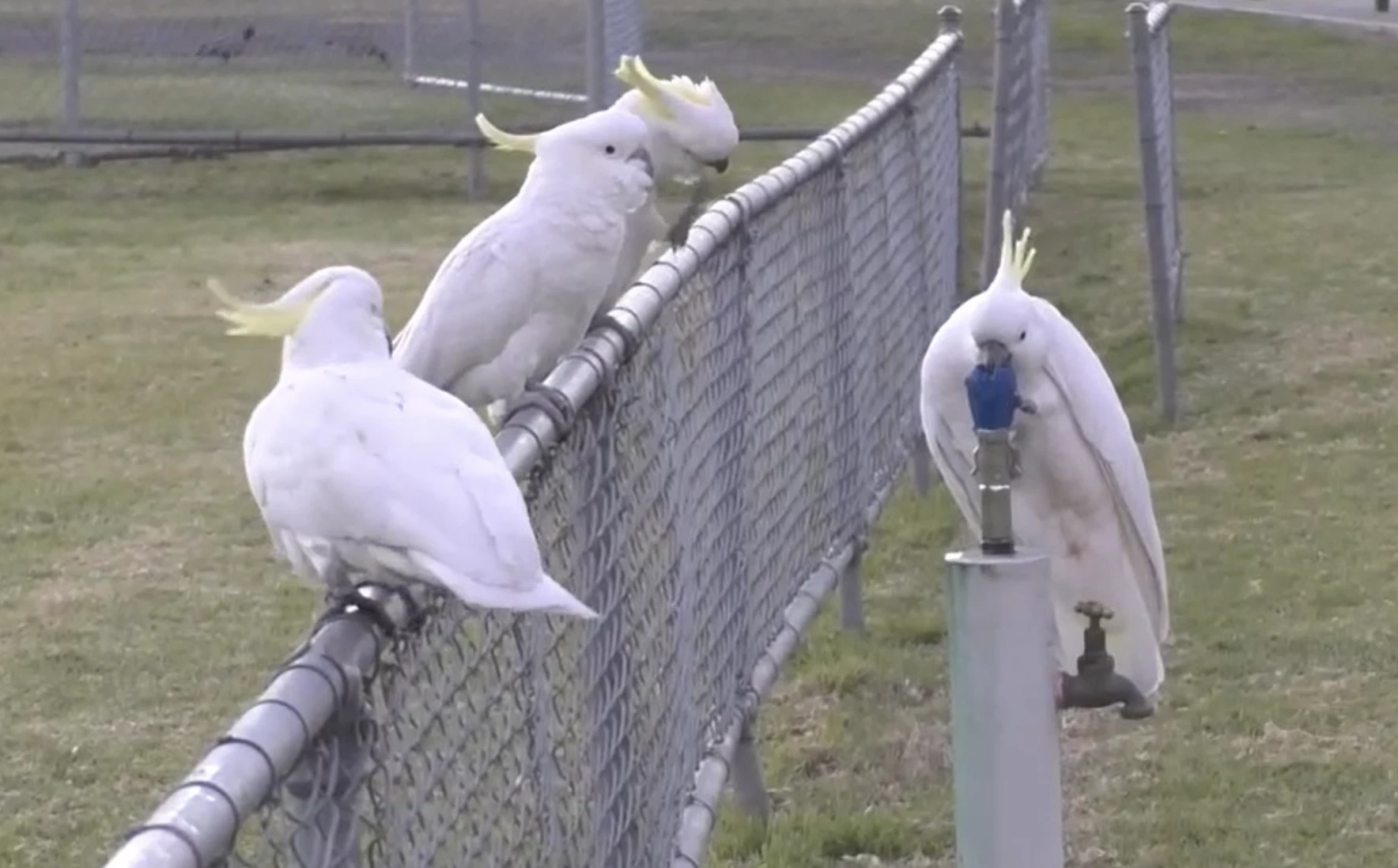In an impressive feat of rapid urban adaptation, sulphur-crested cockatoos have worked out how to use their feet and their large bodies to twist the tap handles of drinking fountains in order to access water from the faucet. It's the first observation of this behavior spread throughout a large population of birds.
In the video above, cockatoos line up next to one of several drinking fountains in a western Sydney park, taking turns to access the water spout. Because the drinking outlets are designed to require constant pressure for water flow, the birds have learnt to not just turn the taps on but maintain pressure on the faucet.
"Overall, these observations showed that individuals operated the drinking fountain using coordinated action with both feet, with one (most often the right) foot on the twist-handle (valve) and one foot gripping the rubber spout (bubbler) or both feet on the valve," the researchers wrote. "The weight of the bird would then be lowered to turn the twist-handle clockwise and keep it from springing back and the head turned to access the flowing water."
Lead author Barbara Klump, of the Max Planck Institute of Animal Behavior, observed this remarkable new adaptation first-hand, which led to studying the scope of this behavior. Identifying the drinking fountains that had telltale cockatoo-use marks – beak bites in the plastic around the outlet – Klump and a team of scientists from Western Sydney University, The Australian National University and the University of Vienna set up cameras to monitor the birds' interactions.
Two dozen regular attendees were also marked with red paint dots, to assess behavioral patterns of those seen frequenting the park's handful of drinking fountains. What they found was that, over 44 days, the birds made 525 attempts at accessing water, with a 41% success rate overall. The birds that had been marked, however, were a little more skilled, with a 52% success rate.
"Public drinking fountains vary in design between local councils but are generally widespread," the researchers wrote. "Yet, to our knowledge, this behavior has not been observed elsewhere. Altogether, this suggests that this drinking innovation has spread to form a new urban-adapted local tradition."

Interestingly, the scientists also observed many different, individualistic ways that the birds attempted to perform the same thing. The most successful birds were able to access the water quickest, and across all the footage, the scientists found that the most common move – that led to both success and failure – was identical.
"Successful sequences consisted of in total 39 unique behavioral actions and across the 440 sequences, we observed 119 unique sequences," the team wrote. "Across the 207 unsuccessful sequences, we observed 88 unique actions and 131 unique sequences. Successful sequences were on average shorter. Interestingly, the two most common sequences in both outcomes (without repetitions) were identical."
So what does this tell us? Well, while "practice makes perfect" applies, learning behaviors in a species operates on a spectrum – much like in humans – so the difference between success and failure may come down to factors such as bird size, coordination and force.
This is now the second opportunistic urban skill that's been observed in the large-bodied cockatoo (Cacatua galerita), a very social species found along the southern, eastern and northern coastline of Australia, as well as Indonesia and Papua New Guinea. Urban spread in some states, particularly New South Wales and Victoria, has seen the birds sharing more and more native habitat with humans. With this, has come some bold foraging moves.

In 2022, the birds made headlines when it became clear they'd learnt how to open the flip lids on household trash cans on "bin night" in Sydney urban areas. This led to residents trying to outsmart the clever birds by putting weights on the lids to prevent the cockatoos from digging through the trash. The birds then worked out how to use their body weight and beaks to push objects such as bricks off the lids. This behavior was first anecdotally recorded in 2019, leading scientists to believe that the birds had learnt from others – so much so it had become a common, widespread adaptation.
As generalist herbivores, they have a natural diet of seeds, fruits and nuts, but – as the trash-diving demonstrates – can tolerate a lot more. This, and other natural behaviors (such as ground-foraging birds having others watching from trees above to warn of any dangers), have made these raucous cockatoos one of the most abundant large birds in Australia.
As for the "cockies" at the drinking fountains, the busiest visitation times were around 7.30 am and 5.30 pm, and it was constant on weekdays and weekends, and hot and cool days. However, numbers dropped off when it was raining. It's also worth noting that the behavior persists even when there are readily available water sources nearby.
The birds have also been seen swinging around power lines, tugging at ropes and fiddling with other urban structures (such as this gate lock below), which suggests there's also a high degree of social play involved in their behavior.

"Here, we identify a drinking innovation in wild parrots, the first such to our knowledge," the researchers added. "The behavior consists of a combination of actions involving both feet, bill and shifting body weight to start the water flow. This apparent complexity in behavior is potentially reflected in our finding that while it appeared to be well-established in the local population, only 52% of attempts by marked birds to operate the drinking fountain were successful. This has interesting parallels to an earlier study on bin-opening in cockatoos where 54% of attempts by marked birds were successful, suggesting similarities in either their physical difficulty or time taken to learn."
For more on their antics, Business Insider presented this entertaining recap in 2022.
The study was published in the journal Biology Letters.
Source: University of Vienna via Scimex









